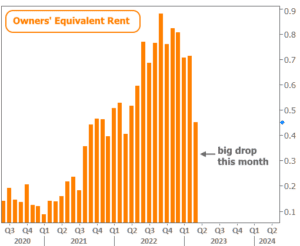The good news is that last November increasingly looks like the moment when rates stopped surging higher at the fastest pace in 40 years. The not-sogood news is that they still don’t seem sure what to do next.
Rates have been able to stop the bleeding due to inflation broadly leveling off over the past 6 months, but mixed messages in the inflation data are preventing a faster drop. This week’s most closely watched inflation report, the Consumer Price Index (CPI), came in just a bit lower than the market expected, but is still fairly far from target levels.


One of the biggest sticking points for services inflation has been the cost of keeping a roof over one’s head. CPI tracks that via a line item known as Owners Equivalent Rent (OER). Much like the broader core CPI, OER is off its highest levels but still much higher than it needs to be.

Last Friday’s jobs report began to push things back in the other direction (toward higher rates). By the end of the present week, Retail Sales made a similar case. It’s not that sales were strong. In fact, overall retail sales fell by 1% versus forecasts calling for a 0.4% decline.
The issue is that investors were prepared to see consumers cut back on spending even faster. The resilience was especially notable in some of the more granular data, such as the “non-store sales” component which accounts for pretty much everything bought on the internet.

At a time when the economy is supposed to be cooling, this data shows consumers just strung together 3 very respectable months. In fact, before the pandemic, there are only 3 other examples of a similar quarter in the past 20 years.
Simply put, investors hoping to see evidence of a rattled consumer would have to look elsewhere or wait for the next report.
The bond market instantly reflected that realization, primarily in the form of Fed rate hike expectations.

Fed rate expectations correlate best with the shortest term bonds, but long-term bonds (which correlate more with mortgage rates) took a hit as well. The 10yr Treasury yield has been trying to sustain a break below 3.4% since December, but continues hitting a wall. Last week looked promising, but this week had other thoughts.

It makes sense for rates to be treating these levels with respect. We’re essentially at an inflection point between the highest post-pandemic rate range and something that’s close enough to what were, at the time, the super high rates of late 2018.
Then there’s the mortgage market. It has had to endure the departure of the Federal Reserve as the biggest, guaranteed buyer of newly originated mortgage debt in the market. That process, known as quantitative tightening, happened in the first 8 months of 2022 and it drastically changed the relationship between mortgage rates and Treasury yields. The spread between the two is still fairly extreme by recent standards, but even when it begins to tighten, without the Fed buying mortgages, we shouldn’t expect to see the “old normal” levels any time soon.

Next week doesn’t boast as many potentially significant economic reports, but bank earnings and comments from Fed speakers can nonetheless cause volatility for markets. On the plus side for rates, the scariest levels are indeed likely behind us unless inflation manages an unexpected resurgence. On the downside, it will remain very difficult for rates to move much lower than they were last week without data that does more to confirm a shift among consumers and/or inflation itself.
Subscribe to my newsletter online at: http://mortgageratesupdate.com/acelandmortgage
